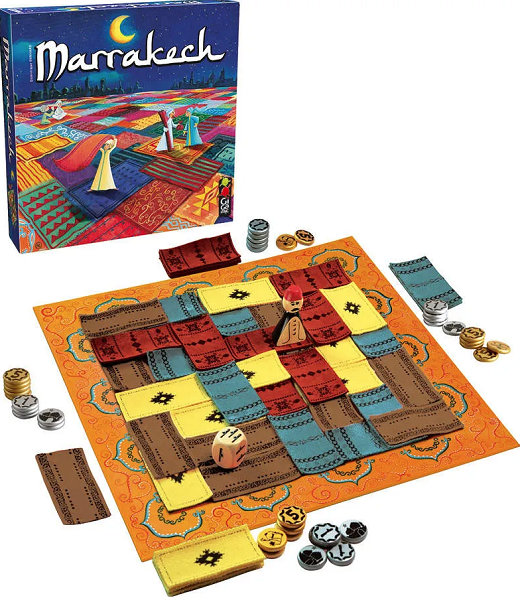Bring Out Your Wares in Rug Placement Game Marrakech

Become a master rug seller by carefully laying out your rugs on the board and making strategic choices regarding the direction you move the buyer.
Published by Gigamic, Marrakech scales nicely across the listed player count and features some very attractive components. But how is the gameplay?
Gameplay
Each player takes a certain number of rugs in their player color and a certain amount of money. The board, which shows a grid of squares, is placed in the center of the table. The Assam meeple is placed in the center square.
You start your turn by choosing whether to keep Assam facing straight or to turn him 90 degrees left or right. You then roll the die and move him that many squares in the direction he is now facing. The die can roll one through four. If he moves out of the grid, arrows direct him as to where he reenters it. If he stops on a space covered by an opponent’s rug, you must pay a fee to the player to whom that rug belongs. You pay one coin for each square covered by that color of rug connected to the group that Assam is standing on. If you ever do not have enough to pay, you are eliminated from the game.
After moving Assam, you must lay down one of your own rugs. Each rug covers two squares on the board. Your rug must be placed so that one half covers a square adjacent to where Assam is currently standing. Either half of a rug may cover one half of another rug; however, an entire rug cannot be placed so that both halves cover the same rug.
The game ends once all rugs have been placed. Each player then earns one point for each coin they have and each half of a rug that is currently visible on the board. The player with the most points wins.

Review
Marrakech is a neat twist on roll-and-move games. The fact that you control your direction means you don’t feel as if you’re completely at the mercy of the die, and as the board starts to fill up with rugs there is a certain push-your-luck element as you decide where to move. Maybe moving forward will move Assam into more open space, reducing your chances of having to pay out, but if you move left and manage to roll a four, you’ll make it across an opponent’s rugs and into an area where you’re more likely to receive a payout on the next player’s turn.
Gameplay is quite easy to learn, but there is still interesting strategy in the area control aspect of the payouts and where you place your rugs. There are several factors to consider and it’s clever that visible rugs not only determine how much you’re paid when they’re landed on, but add to your final score as well. You want to create sets of rugs to make them more valuable when others land on them, but you also use them to block other player’s rugs.
There is player elimination but we didn’t find this to be a common occurrence, and it’s simply a deterrent from running recklessly into enemy rug territory. The game also plays pretty fast, so even if you were eliminated near the end, you wouldn’t have long to wait.
While the game works pretty well across all its player counts, in a two-player game each player is supposed to take two sets of rugs and mix them together, drawing them at random each turn. However, the rulebook is not clear if you are supposed to be able to look at the order the rugs are coming in or not, and it’s hard not to when the backs of each rug set is a different color. In general, a little more information on the two-player variant would be useful.
The components are quite well done with the rugs being made from actual cloth, but a material that doesn’t slide around or easily lose its location on the board. The Assam meeple is big and chunky and fun to move around while the die is nice to roll. Everything about the game is just really nicely put together.
Marrakech is a nice balance between luck and strategy. Turns are fast, downtime minimal, and production quality quite nice, and there is a fun escalation to the gameplay as the board fills up more and more and choices become more difficult.
Pros: Great component quality, fast turns, multi-purpose rug placement
Cons: Two-player rules could use some clarification
Disclosure: we received a complimentary review copy of this game.







